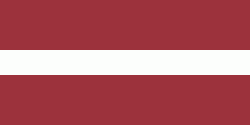Kuldīga District (Kuldīgas novads)
Kuldīga District (Kuldīgas rajons) was an administrative division of Latvia, located in Courland region, in the country's west. It was organized into a city and thirteen parishes, each with a local government authority. The main city in the district was Kuldīga.
The district was located in the western part of Latvia on both sides of the Venta River. It had borders with 5 other former districts: Ventspils, Talsi, Tukums, Saldus and Liepāja. The borders of the district that it had when it was dissolved were established in 1950.
Districts were eliminated during the administrative-territorial reform in 2009.
The district occupied an area of 2,499.87 km2, has a population of 37,119 — 13,335 in the main town of Kuldīga.
Railroads in Kuldīga district connect Riga to Liepāja and Liepāja to Ventspils, the latter being closed for public traffic. Also, one of the main roads in Latvia — route A9 from Riga to Liepāja goes through the territory. The main industries are agriculture, wood processing, forestry, and fish farming.
The district was located in the western part of Latvia on both sides of the Venta River. It had borders with 5 other former districts: Ventspils, Talsi, Tukums, Saldus and Liepāja. The borders of the district that it had when it was dissolved were established in 1950.
Districts were eliminated during the administrative-territorial reform in 2009.
The district occupied an area of 2,499.87 km2, has a population of 37,119 — 13,335 in the main town of Kuldīga.
Railroads in Kuldīga district connect Riga to Liepāja and Liepāja to Ventspils, the latter being closed for public traffic. Also, one of the main roads in Latvia — route A9 from Riga to Liepāja goes through the territory. The main industries are agriculture, wood processing, forestry, and fish farming.
Map - Kuldīga District (Kuldīgas novads)
Map
Country - Latvia
 |
 |
| Flag of Latvia | |
After centuries of Teutonic, Swedish, Polish-Lithuanian and Russian rule, which was mainly executed by the local Baltic German aristocracy, the independent Republic of Latvia was established on 18 November 1918 when it broke away from the German Empire and declared independence in the aftermath of World War I. However, by the 1930s the country became increasingly autocratic after the coup in 1934 establishing an authoritarian regime under Kārlis Ulmanis. The country's de facto independence was interrupted at the outset of World War II, beginning with Latvia's forcible incorporation into the Soviet Union, followed by the invasion and occupation by Nazi Germany in 1941, and the re-occupation by the Soviets in 1944 to form the Latvian SSR for the next 45 years. As a result of extensive immigration during the Soviet occupation, ethnic Russians became the most prominent minority in the country, now constituting nearly a quarter of the population. The peaceful Singing Revolution started in 1987, and ended with the restoration of de facto independence on 21 August 1991. Since then, Latvia has been a democratic unitary parliamentary republic.
Currency / Language
| ISO | Currency | Symbol | Significant figures |
|---|---|---|---|
| EUR | Euro | € | 2 |
| ISO | Language |
|---|---|
| LV | Latvian language |
| LT | Lithuanian language |
| RU | Russian language |















